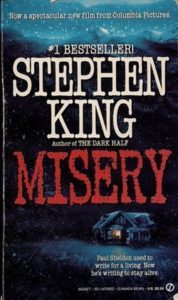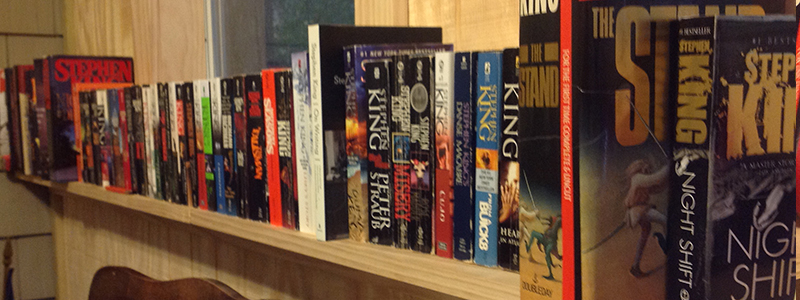by Jay Wilburn
The plan is to reread all of Stephen King’s works in the order that they were published. Richard Chizmar of Cemetery Dance had the vision. I’m doing it because I am a writer and I want to improve my fiction. And I love Stephen King’s stories. I think there is something to be learned through this process.
You can also go back to the beginning and read Before Carrie or any of my other posts up through this one and beyond by checking out this link to the Master List of all my #StephenKingRevisited posts.
Let’s take a look at Misery, you cockadoodie dirty birdies …

When King thanks three medical professionals at the beginning of a novel, you know you are in for a bumpy ride.
The first six words of Misery are nonsense words that will only make sense later. Much of this book and especially this first section reads like a drug-induced haze. I don’t mean that as an insult. Imagery of the splintered pilings at the beach and the tides to describe the pain of his broken bones is excellent. The imaginary courtroom as he tries to figure out his captor was quite well done.
King pulls the carpet out from under our expectations many times during this book.
Annie Wilkes as a formidable villain in terms of her mind and outsmarting the smart writer again and again makes her a good foil for our hero’s best and worst laid plans. Annie Wilkes is called the Constant Reader. We the readers are partly the villain of this story. Addiction may be the rest of it, I suppose
The tools in Paul’s mind help tell this story where the POV character spends much of the story in a bed and then most of the novel in a single room. King tackles this bottle story style again in the novel Gerald’s Game.
Annie’s discovery of Misery’s fate came sooner in the story than I recalled. Paul has been a dirty birdie. 51 hours can be a terrifying number.
There is a great terror in not being able to save your work on Carbonite.
1001 Arabian Nights and writing for your life to the hungry audience of constant readers is a great theme in this book playing with layers. Constant readers becoming merciless editors is something I am probably guilty of. Constant reader does not mean constant sap, the character points out.
“Writing does not cause misery, it is born in misery.” – Montaigne
Having to read large sections of Misery’s Return, the book within the book, is hit or miss. It is a little bit of a heavy aside much like in “The Body” novella in Different Seasons. The typesetting for the story within the story, complete with handwritten letters for the missing keys on the character’s typewriter, had to drive the formatters crazy in every printing.
This book may be as good a discussion on the writing process as On Writing.
“Can you? Did he?” is a powerful idea about writing. You get into a corner and have to get out, so you ask yourself, can you? Once you decide you can, the audience answers, did he?
The hole in the paper is the act of imagination and getting engrossed in the story being written, the well of his creativity, the well of dreams, that no drug could stop. He also writes of the sweatshop down below his conscious mind that sent up flairs of ideas.
His output increases because he is being forced to live a clean and straight life.
The scene inside a scrapbook with slashed words on a page provides a nice existential scare, I think.
“The Gotta” is a great description of a reader hooked on a story and anyone hooked on anything.
Any time a rat shows up in a Stephen King story, I know I’m in trouble. Every. Time.
Page 191 of my copy had a lot of smeared text. It took some serious forensic reconstruction on my part.
The character writer says that you always think you know how a story you’re writing will turn out, but he never had one go exactly that way.
Kelfex antibiotic played a big role in the second dark tower book right before it appears in this book, too. “Obdurant” appears again in this book. I noticed it in previous books because it was such a huge theme in 11/22/63. Lips pressed together until they almost disappear is a very Stephen King thing for his characters. When our main character’s arms are cuffed to the bed, that may have been the seed for Gerald’s Game. I wonder if King asked himself, could I, when he wondered if the character could have survived were he left handcuffed that way indefinitely. Sidewinder, Colorado is the town from which an artist is going to go to sketch the ruins of the Overlook hotel from The Shining.
The story discusses IMB correct tape. The main character had a cassette tape in the machine under the dash. Mash and WKRP play on the TV in the other room. Then, there is a Ginzu knife commercial. We have a Hart for President bumper sticker. Someone goes out to buy a VCR. Caviar is available in first class on airplanes in this time.
“The’re” appears in a sentence where “they’re” would make sense. Most of these typos appear in reprintings of his books and less so in older copies I’m able to go back and cross reference. Modern editors and proofreaders are not catching as many things, it appears.
Remember to support the Sidewinder Blue Devils.
King’s character says the reason an author puts a dedication in a book is because their selfishness horrifies even them in the end.
And now my tale is told, King signs off the book.
I’m still your number one fan.
My next post will be Before The TommyKnockers which will be linked on the Master List of all my Stephen King Revisited posts.





